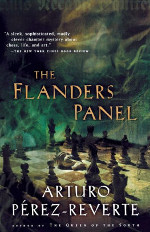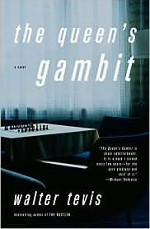Masters of the Game | The Reader's Shelf
You don’t have to be a chess buff or even know more than the rudiments of the game to appreciate these novels in which it is prominently featured. Check them out!
Katherine Neville’s gloriously overstuffed adventure thriller The Eight (Ballantine. 1997. ISBN 9780345419088. pap. $17; ebk. ISBN 9781504013673) centers on the Montglane Service, an ornate chess set once owned by Charlemagne whose jewels are far less valuable than the world-changing secrets it encodes. Two women play key roles in its history: in the 1970s an American computer expert races to unite and interpret the set, while in the 1790s a novice nun struggles to keep its pieces out of the wrong hands during the horrors of the French Revolution. This is a big book with something for everyone: action, espionage, puzzles, and just enough scientific and historical fact to add a patina of plausibility to Neville’s imaginings.
 “Who killed the knight?” reads a newly uncovered inscription on a 15th-century Flemish painting, a find that sets in motion the plot of Arturo Pérez-Reverte’s The Flanders Panel (Mariner: Houghton Harcourt. 2004. ISBN 9780156029582. pap. $15.95; ebk. ISBN 9780547539584). The painting itself depicts two noble gentlemen playing chess while an enigmatic woman reads a book in the background. Julia, the young art restorer who finds the inscription, uses historical research along with clues embedded in the arrangement of the chess pieces themselves to solve a long-ago murder. At the same time, she dodges threats to her own life originating from somewhere in the shadowy art world in which she moves. Pérez-Reverte’s smart thriller stimulates the brain as much as the nerves.
“Who killed the knight?” reads a newly uncovered inscription on a 15th-century Flemish painting, a find that sets in motion the plot of Arturo Pérez-Reverte’s The Flanders Panel (Mariner: Houghton Harcourt. 2004. ISBN 9780156029582. pap. $15.95; ebk. ISBN 9780547539584). The painting itself depicts two noble gentlemen playing chess while an enigmatic woman reads a book in the background. Julia, the young art restorer who finds the inscription, uses historical research along with clues embedded in the arrangement of the chess pieces themselves to solve a long-ago murder. At the same time, she dodges threats to her own life originating from somewhere in the shadowy art world in which she moves. Pérez-Reverte’s smart thriller stimulates the brain as much as the nerves.
A game of chess provides the defining metaphor in Joanne Harris’s novel of academic intrigue, Gentlemen and Players (Morrow. 2006. ISBN 9780060559151. pap. $15.99; ebk. ISBN 9780061839917). The “board” is St. Oswald’s, an English grammar school for boys. The “players” are Roy Straitley, a classics teacher facing retirement, and his unnamed opponent, a newly hired teacher with a simmering grudge against the school who is determined to undermine it from within. While these antagonists use their wits to battle over the fate of the school, their cleverness pales before Harris’s own as she skillfully directs and misdirects readers’ attention. Think you have the book figured out? You won’t know how wrong you are until the author reveals all.
Michael Chabon’s The Yiddish Policemen’s Union (Harper Perennial. 2008. ISBN 9780007149834. pap. $16.99; ebk. ISBN 9780062124586) conceives of an alternate history in which Franklin Delano Roosevelt has given Europe’s Jews a temporary home in Alaska. In the time allotted to them to stay, they create a multilayered society, complete with a believably bedraggled underclass rife with criminals, strange sects, and scheming conspirators. As the clock ticks on the Jewish settlement, Meyer Landsman, a hard-boiled policeman, investigates the murder of his chess master neighbor, whose body is found near an in-progress game. The match provides both a clue to the murderer and a metaphor for the situation in which Alaska’s “frozen chosen” find themselves.
 Paolo Maurensig’s biographical novel Theory of Shadows (Farrar. 2018. ISBN 9780374273804. $23; ebk. ISBN 9780374715915) pictures the last days of Alexander Alekhine, a real-life Russian-born world chess champion who died under suspicious circumstances in 1946. In his postwar Portuguese exile, he’s down at heel and tormented by a past that includes complicity with Nazis. The tension, and the mystery, of the novel derives from anticipating which of his many circling enemies (real? imagined?) will finally do him in, assuming he does not accomplish the deed himself. Readers are told more than once that the Portuguese fertilize their vineyards with the carcasses of dogs, and this contrast between the refined and the revolting shapes Maurensig’s elegant novel.
Paolo Maurensig’s biographical novel Theory of Shadows (Farrar. 2018. ISBN 9780374273804. $23; ebk. ISBN 9780374715915) pictures the last days of Alexander Alekhine, a real-life Russian-born world chess champion who died under suspicious circumstances in 1946. In his postwar Portuguese exile, he’s down at heel and tormented by a past that includes complicity with Nazis. The tension, and the mystery, of the novel derives from anticipating which of his many circling enemies (real? imagined?) will finally do him in, assuming he does not accomplish the deed himself. Readers are told more than once that the Portuguese fertilize their vineyards with the carcasses of dogs, and this contrast between the refined and the revolting shapes Maurensig’s elegant novel.
Walter Tevis proves in The Queen’s Gambit (Vintage. 2003. ISBN 9781400030606. pap. $16; ebk. ISBN 9780795343063) that a skilled writer does not need fanciful elements to tell a nail-biting story. There are neither murders, codes, nor conspiracies here, just Beth Harmon, a teenage chess prodigy whose skills are matched only by her determination. Born poor in the 1950s, she learns chess from the janitor in the orphanage where she spends her childhood, only quickly to master the game and rise to ever greater heights in the world of tournament play. Along the way, she faces progressively more formidable opponents while confronting her own all-too-human limitations. A riveting writer, Tevis makes the descriptions of the games as exciting as the life and death contests held in the gladiatorial arenas of ancient Rome.
This column was contributed by Steven Jablonski, Collection Development Librarian, Skokie Public Library, IL
ALREADY A SUBSCRIBER? LOG IN
We are currently offering this content for free. Sign up now to activate your personal profile, where you can save articles for future viewing







Add Comment :-
Comment Policy:
Comment should not be empty !!!